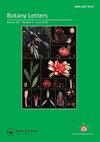原生孢子和原生孢子:最古老的陆生植物衍生孢子,隐孢子还是原生孢子?
IF 1.3
4区 生物学
Q3 PLANT SCIENCES
引用次数: 3
摘要
摘要据报道,最古老的隐孢子来源于陆地植物(胚胎植物),目前被认为是在中奥陶纪。1960年代描述的阿尔及利亚早奥陶世(Tremadocian)的Virgatasporites和Attritasporates两个属在形态上与中间孢子接近,因此造成了一个困境,因为这些孢子状微体化石是在最古老的陆地植物衍生孢子首次出现之前记录的。对两属及其种的分类学、生物地层学和古生物地理学进行了修订。这两个属都分布在寒武纪晚期和中奥陶世之间冈瓦纳大陆边界的许多地方。到目前为止,它们还没有在其他古大陆的边缘被发现。分类群的生物学亲和性仍不确定。一些作者认为这两个属是孢子状微体化石,而其他作者则将其归类为肢端微体化石(acritachs),即具有未知生物亲和力的有机壁微体化石。由于到目前为止还不能清楚地确定与胚胎植物谱系的关系,其生物学联系仍然是个谜。因此,在缺乏其他证据的情况下,在已知其真正的生物学亲和力并将其充分归入生物学类群之前,应将分类群Virgatasporites和Attritasporates暂时归类为incertae sedis,即acritachs。本文章由计算机程序翻译,如有差异,请以英文原文为准。
Virgatasporites and Attritasporites: the oldest land plant derived spores, cryptospores or acritarchs?
ABSTRACT The oldest reported occurrence of cryptospores supposed to derive from land plants (embryophytes) is currently considered to be in the Middle Ordovician. The two genera Virgatasporites and Attritasporites, described in the 1960ʹs from the Early Ordovician (Tremadocian) of Algeria, are morphologically close to the miospores, and therefore pose a dilemma, because these spore-like microfossils are recorded before the first appearance of the oldest land plant derived spores. Here the taxonomy, biostratigraphy and palaeobiogeography of the two genera and their species are revised. Both genera are found in many localities on the Gondwanan border between the late Cambrian and the Middle Ordovician. They have not been found at the margins of other palaeocontinents so far. The biological affinity of the taxa remains uncertain. Several authors considered the two genera to be spore-like microfossils, whereas other authors classified them as acritarchs, i.e. organic-walled microfossils of unknown biological affinity. As the relationship to the embryophyte lineage cannot be established clearly to date, the biological affiliation remains enigmatic. Therefore, in the absence of other evidence, the taxa Virgatasporites and Attritasporites should be temporarily classified as incertae sedis, i.e. as acritarchs, before their true biological affinity is known and they can be adequately placed into a biological group.
求助全文
通过发布文献求助,成功后即可免费获取论文全文。
去求助
来源期刊

Botany Letters
Agricultural and Biological Sciences-Plant Science
CiteScore
3.10
自引率
6.70%
发文量
54
期刊介绍:
Botany Letters is an international scientific journal, published by the French Botanical Society (Société botanique de France) in partnership with Taylor & Francis. Botany Letters replaces Acta Botanica Gallica, which was created in 1993, building on over a century of renowned publications by the Société botanique de France.
 求助内容:
求助内容: 应助结果提醒方式:
应助结果提醒方式:


